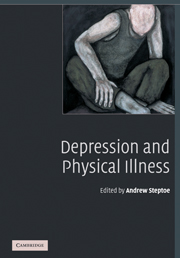Book contents
- Frontmatter
- Contents
- List of contributors
- Preface
- Part 1 Introduction to depression and its determinants
- Part 2 Depression and specific health problems
- 3 Depression and the development of coronary heart disease
- 4 Depression and prognosis in cardiac patients
- 5 The management of depression in patients with coronary heart disease
- 6 Depression and physical disability
- 7 Chronic pain and depression: twin burdens of adaptation
- 8 The interrelationship of depression and diabetes
- 9 Depression and chronic fatigue
- 10 Cancer and depression
- 11 Depression and obesity
- Part 3 Biological and behavioural processes
- Part 4 Conclusions
- Index
- References
8 - The interrelationship of depression and diabetes
from Part 2 - Depression and specific health problems
Published online by Cambridge University Press: 17 September 2009
- Frontmatter
- Contents
- List of contributors
- Preface
- Part 1 Introduction to depression and its determinants
- Part 2 Depression and specific health problems
- 3 Depression and the development of coronary heart disease
- 4 Depression and prognosis in cardiac patients
- 5 The management of depression in patients with coronary heart disease
- 6 Depression and physical disability
- 7 Chronic pain and depression: twin burdens of adaptation
- 8 The interrelationship of depression and diabetes
- 9 Depression and chronic fatigue
- 10 Cancer and depression
- 11 Depression and obesity
- Part 3 Biological and behavioural processes
- Part 4 Conclusions
- Index
- References
Summary
… in the pre-war literature, diminished glucose tolerance was frequently reported to be statistically demonstrable in patients with melancholia.
H. M. Von Praag (1965)Introduction: diabetes
The worldwide prevalence of diabetes is increasing at an alarming rate. According to the World Health Organization (WHO), approximately 150 million people worldwide have diabetes mellitus. Due to the combined impact of sedentary lifestyles, increased prevalence of obesity, and the rising age of the population, this number may double by 2025. In developed countries, people aged 65 or older will be at highest risk; however, most new cases in developing countries will be individuals between 45 and 64 years of age. Countries reporting the largest number of cases are India, followed (in order) by China, the USA, Indonesia, Japan, Pakistan, Russia, Brazil, Italy and Bangladesh [1]
Diabetes mellitus is a heterogeneous metabolic disease in which hyperglycaemia is a central feature. Diabetes is the world's leading cause of non-traumatic limb amputation, new cases of end-stage renal disease [2] and blindness in adults [1, 3]. Nearly 50% of the 18 million diabetes patients in the USA are unaware of their diabetes [4]; in some countries, that number may be as high as 80% [5]. Other debilitating consequences of diabetes include diabetic neuropathy and foot ulcers. Diabetes is the fourteenth leading cause of death worldwide and also contributes to cardiac and stroke-related morbidity and mortality.
Keywords
- Type
- Chapter
- Information
- Depression and Physical Illness , pp. 165 - 194Publisher: Cambridge University PressPrint publication year: 2006
References
- 5
- Cited by



